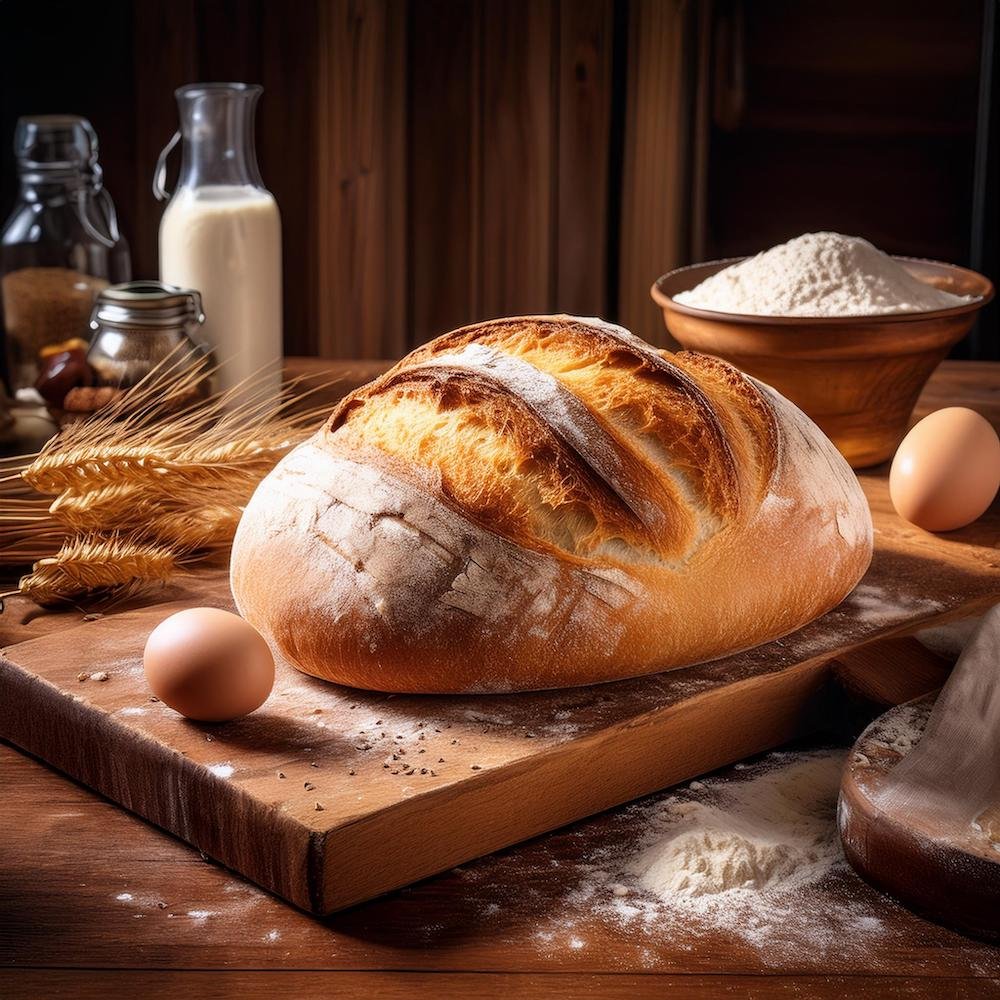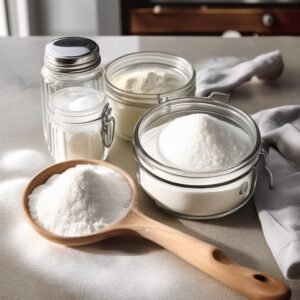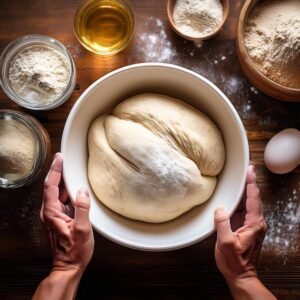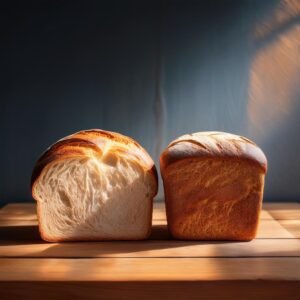What Is a Substitute for Baking Soda in Bread Recipes? Baking is both an art and a science, and each ingredient plays a crucial role in the final product. Baking soda, also known as sodium bicarbonate, is a key leavening agent in many bread recipes. When combined with an acidic ingredient, such as buttermilk or vinegar, it produces carbon dioxide gas, which helps the bread rise and develop a light, airy texture.
However, there are times when you need to know what is a substitute for baking soda in bread recipes. Perhaps you’ve run out, or you’re looking for a substitute that aligns with specific dietary needs. Whatever the reason, understanding your options is the first step to making successful bread without baking soda.
Let’s start by understanding the role of baking soda in bread recipes before diving into the best substitutes.
Understanding Baking Soda
To effectively substitute baking soda in bread recipes, it’s important to understand its function. Baking soda is more than just a leavening agent—it plays a pivotal role in the science of baking. Here’s what you need to know:
What is Baking Soda?
Baking soda, or sodium bicarbonate, is an alkaline compound. It reacts with acidic ingredients to produce carbon dioxide gas, which creates air pockets in the batter or dough. These air pockets cause the bread to rise, resulting in a light and fluffy texture.
How Does Baking Soda Work in Bread Recipes?
The effectiveness of baking soda relies on two key components:
- Acidic Ingredients: Baking soda needs an acid to activate. Common acidic ingredients in bread recipes include buttermilk, yogurt, vinegar, lemon juice, or cream of tartar.
- Heat Activation: Once the baking soda reacts with the acid, the carbon dioxide bubbles expand during baking, helping the bread rise.
Without baking soda or a suitable substitute, bread may become dense and flat, lacking the desired texture.
When Is Baking Soda Used in Bread?
Baking soda is often used in:
- Quick Breads: Recipes that do not require yeast, such as banana bread or cornbread.
- Sweet Breads: Where acidic ingredients like molasses or honey are present.
- Savory Breads: Such as Irish soda bread, which relies heavily on baking soda for its leavening.
Challenges of Replacing Baking Soda
Because baking soda is a highly concentrated leavening agent, it requires careful substitution. Common challenges include:
- Loss of Rise: Substitutes may not provide the same level of leavening, leading to denser bread.
- Flavor Changes: Some substitutes may alter the taste of the bread.
By understanding how baking soda functions, you can choose a substitute that complements your recipe and minimizes these challenges.
How to Use Baking Soda Substitutes in Bread Recipes
Successfully substituting baking soda in bread recipes requires adjustments to ingredients, measurements, and techniques. Follow these tips to achieve the best results with your chosen substitute.
1. Adjust Measurements
Substitutes for baking soda are often less concentrated, so you’ll need to adjust quantities:
- Baking Powder: Use three times the amount of baking powder as baking soda.
- Cream of Tartar with Baking Soda: Use a 2:1 ratio of cream of tartar to baking soda.
- Self-Rising Flour: Replace both the flour and baking soda in the recipe, but omit additional salt.
Tip: Keep a digital scale handy for precise measurements, especially when working with leavening agents.
2. Balance Acidity
Baking soda works in tandem with acidic ingredients, such as buttermilk or vinegar. If you’re using a substitute like baking powder, which already contains acid, you may need to reduce or omit additional acidic ingredients.
Example:
- Replace buttermilk with regular milk if the recipe already has baking powder as the substitute.
- Use lemon juice sparingly to prevent overpowering flavors.
3. Maintain Proper Texture
Certain substitutes, like club soda or self-rising flour, can affect the batter’s texture:
- Club Soda: Incorporate it gently to retain its carbonation and prevent overmixing.
- Self-Rising Flour: Adjust other dry ingredients to maintain the right dough consistency.
Tip: If the batter appears too runny after substitution, add a little more flour to restore the desired thickness.
4. Plan for Leavening Time
Substitutes like yeast require additional time to work:
- Mix the yeast with warm water (not hot) to activate it before combining it with the dough.
- Allow the dough to rise in a warm, draft-free place for 1–2 hours until it doubles in size.
Tip: Cover the dough with a damp cloth during rising to prevent it from drying out.
5. Use Proper Mixing Techniques
Mixing techniques can influence how well the substitute performs:
- Whipped Egg Whites: Gently fold stiff peaks into the batter, avoiding overmixing to retain air bubbles.
- Baking Powder or Cream of Tartar: Mix these thoroughly with the dry ingredients before combining with liquids to ensure even distribution.
6. Monitor Baking Time
Substitutes may alter the recipe’s rise and cooking time:
- Recipes using baking powder or self-rising flour may bake faster due to their quick-acting nature.
- Yeast-based substitutes require longer cooking times due to the dough’s density.
Tip: Check for doneness a few minutes before the recipe’s original baking time. Use a toothpick or skewer to ensure the bread is baked through.
7. Taste and Adjust
Some substitutes can subtly change the flavor of your bread:
- Baking powder or self-rising flour may add a slight tang due to their acidity.
- Yeast provides a savory, fermented flavor, making it ideal for artisan-style breads.
Tip: Enhance flavor by adding herbs, spices, or sweeteners to complement the substitute’s profile.
8. Test and Learn
Baking requires experimentation, especially when substituting key ingredients:
- Start with small batches to test how a substitute behaves in your recipe.
- Take notes on texture, flavor, and rise for future improvements.
By understanding how to adapt recipes to your chosen substitute, you can maintain the integrity of your bread while exploring new flavors and techniques.
Common Challenges and Solutions When Substituting Baking Soda in Bread Recipes
Substituting baking soda in bread recipes can sometimes lead to unexpected results. Here are common challenges you might encounter and practical solutions to ensure your bread turns out perfectly every time.
1. Bread Doesn’t Rise Properly
Challenge: Your bread may end up dense or flat because substitutes don’t always replicate the full leavening power of baking soda.
Solution:
- Use a Stronger Substitute: Opt for baking powder or a cream of tartar and baking soda mix, which are more reliable for leavening.
- Combine Substitutes: Pair whipped egg whites with club soda for a boost in lightness.
- Ensure Proper Mixing: Thoroughly combine the leavening agent with dry ingredients to ensure even distribution throughout the batter.
2. Off Flavors in the Bread
Challenge: Some substitutes, like vinegar or baking powder, can alter the flavor of your bread.
Solution:
- Balance Acidity: Reduce or omit additional acidic ingredients, such as buttermilk or lemon juice, when using baking powder.
- Enhance Flavor: Mask any undesirable tang by adding complementary flavors, such as vanilla extract, cinnamon, or herbs.
3. Texture Is Too Dense
Challenge: The bread lacks the airy and fluffy texture typically achieved with baking soda.
Solution:
- Don’t Overmix: Overmixing can activate gluten, leading to a denser texture. Stir the batter just until combined.
- Incorporate Air: Use whipped egg whites or club soda to introduce air into the batter.
- Allow Rising Time: If using yeast, give the dough sufficient time to rise before baking.
4. Bread Is Too Dry or Crumbly
Challenge: Without baking soda’s alkalinity, the bread may lose moisture during baking, resulting in a dry or crumbly texture.
Solution:
- Adjust Liquid Ratios: Add a tablespoon of milk, yogurt, or sour cream to restore moisture.
- Monitor Baking Time: Check the bread a few minutes before the recommended time to prevent overbaking.
5. Substitutes Don’t Activate Properly
Challenge: Substitutes like baking powder or yeast may fail to activate if not used correctly.
Solution:
- Measure Accurately: Baking is precise, so ensure you use the correct proportions of substitutes.
- Fresh Ingredients: Use fresh baking powder or yeast, as expired leavening agents lose effectiveness.
- Warm Liquids: For yeast, use lukewarm water (around 110°F) to activate it without killing the live cultures.
6. Uneven Texture or Baking
Challenge: Substitutes may cause uneven distribution of air bubbles, leading to inconsistent texture.
Solution:
- Combine Dry Ingredients First: Mix the substitute thoroughly with the flour and other dry ingredients before adding liquids.
- Use the Right Pan: Choose a pan that promotes even heat distribution, such as a glass or ceramic loaf pan.
- Rotate During Baking: If your oven has hot spots, rotate the bread halfway through baking for even cooking.
7. Overpowering Flavor of Substitutes
Challenge: Strong substitutes like vinegar or lemon juice can overpower the overall taste of the bread.
Solution:
- Dilute Acidity: Use milder acidic ingredients like buttermilk instead of vinegar or lemon juice.
- Add Sweetness: A small amount of sugar or honey can balance and soften strong flavors.
Frequently Asked Questions (FAQs)
1. What Can I Use Instead of Baking Soda in Bread?
You can replace baking soda with:
Baking Powder: Use 3 teaspoons for every teaspoon of baking soda.
Cream of Tartar + Baking Soda: Combine 2 teaspoons cream of tartar with 1 teaspoon of baking soda.
Self-Rising Flour: Swap it for all-purpose flour.
Club Soda: Replace some or all liquids for added lightness.
Yeast: Best for recipes that allow rising time.
Choose a substitute based on your recipe’s requirements.
2. What Can I Substitute for 1 Teaspoon of Baking Soda?
Options to replace 1 teaspoon of baking soda include:
3 teaspoons baking powder: An easy and effective option.
Combine 1 teaspoon of cream of tartar with ½ teaspoon of baking powder for a balanced and reliable option.
1 teaspoon yeast: Ideal for fermented bread.
1 teaspoon whipped egg whites: Adds lightness to quick bread.
Adjust liquids and acids for best results.
3. What to Use When There Is No Baking Soda?
Try these versatile substitutes:
Baking Powder: The simplest choice.
Vinegar or Lemon Juice + Baking Powder: Mimics baking soda’s reaction.
Self-Rising Flour: Handy for quick recipes.
Club Soda: Great for light batters.
Choose based on your recipe and available ingredients.
4. What Happens If You Don’t Add Baking Soda to Bread?
Without baking soda, bread may:
Lose Rise: Resulting in a denser texture.
Have a Heavier Crumb: Instead of being light and fluffy.
Taste Different: Acidity may not balance, creating tangier flavors.
Using a substitute ensures the desired rise, texture, and flavor.
Suggested Internal Links:
- Will Bread Rise Without Baking Soda?
A relevant exploration of the science behind baking soda substitutes, aligning closely with the topic of the article. - What Can I Use If I Don’t Have Baking Soda?
Discusses general substitutes for baking soda, which complements the specific focus on bread recipes. - Banana Bread Recipe Without Baking Soda
Provides a practical example of a recipe using a substitute for baking soda, offering readers actionable insights. - What Can I Use If I Don’t Have Baking Soda for Banana Bread?
Delivers a targeted look at substitutes specific to banana bread, enriching the discussion of bread-related solutions. - Is It OK to Bake Without Baking Soda?
Offers a broader perspective on baking without baking soda, adding depth to the article’s focus on substitutions.
Conclusion
Substituting baking soda in bread recipes is easier than it seems when you understand the science behind leavening. Whether you choose baking powder, cream of tartar, self-rising flour, or even yeast, there’s a solution for nearly every type of bread. Each substitute offers unique advantages and may slightly alter the texture or flavor, but with the right adjustments, you can still achieve delicious results.
The next time you’re wondering what is a substitute for baking soda in bread recipes, don’t panic! Use the tips and techniques outlined in this guide to confidently experiment with substitutes and enjoy perfectly baked bread every time.
Happy baking!
Craving more tasty recipes? Make sure to follow us on Facebook , Instagram, Pinterest, and Twitter for daily updates and kitchen inspiration!




